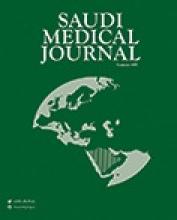To the Editor
I read the article on out-of-hospital cardiac arrests (OHCA) in its entirety and with a great interest.1 Bin Salleeh et al1 original research on OHCA is an outstanding milestone since Conroy and Jolin’s research in late 1990’s.2 The Bin Salleeh et al research should lead to a collaborative nationwide effort among Universities and tertiary level hospitals in publishing data related to OHCA and to address the paucity of OHCA prevalence report in the Middle East.3 McNally4 stated that communities that do not measure their OHCA outcome are not only unable to gauge their performance, but they lack a reference point for quality improvement. Bin Salleeh et al1 study provides a measure to help us appraise and use as reference. What remains is for the region to have a registry. There are many exemplary registry, which galvanized their efforts such as the Pan-Asian Resuscitation outcomes Study (PAROS) in Asia, the European Registry of Cardiac Arrest (EuReCa), and Cardiac Arrest Registry to Improve Survival (CARES) program in USA. In Saudi Arabia, are there any working group panels for OHCA even in an informal basis? And what are the likelihood of establishing a Cardiac Arrest Registry in Saudi Arabia or Middle East in the near future? Or perhaps put it forthright, should the authors lead the way toward a National Cardiac Arrest Registry.
There has not been any research related to the role of Emergency Medical Services (EMS) in the region, but your study findings suggested a low, but increased use of EMS. The role of EMS, the quality of their response, and confidence level in EMS lead me to a query related to your finding; how many of the 4 non-traumatic patients who had a return of spontaneous circulation were transported by EMS? Would you be able to assert that patients transported with EMS have a better outcome?
Reply from the Author
We thank Dr. Alamin Berhanu for his valuable comments regarding our work. He emphasized on the same points we already mentioned in our article. It has been mentioned when we discussed the study limitation “This study was limited to a single university hospital and this limitation could be removed by establishing a national registry of OHCA in Saudi Arabia. Such a registry would allow for national research to identify risk factors, patient characteristics, and trends in Saudi Arabia. In addition, this study supports the continued efforts for public awareness campaigns related to out-of-hospital cardiopulmonary resuscitation (CPR) and attempts to increase survival rates” Regarding his questions: 1) Are there any working group panel for OHCA in Saudi Arabia even in an informal basis? And what are the likelihood of establishing a cardiac registry in Saudi Arabia or Middle East in the near future? Or perhaps put it forthright, should the authors lead the way toward a national cardiac registry.
We are not aware if there is an interest or working group panel for OHCA in Saudi Arabia; however, the team involved in this study is interested in the topic and considering the idea of establishing a registry, on the other hand there is gulf registry for acute coronary syndrome not including OHCA in their database. The group has submitted similar work for pediatric age group for publication 2) How many of the 4 non-traumatic patients who had a return of spontaneous circulation in your study were transported by EMS? There are 3 non-traumatic patients were brought by the family member(s), while the other one was brought by a rehabilitation center ambulance, 3) Would you be able to confidently assert that patient transported with EMS have a better outcome. Since all of the 4 patients who had return of spontaneous circulation in our study were not transported by EMS system, it will be difficult to conclude that they would have a better outcome, we need to study larger population from different sites to demonstrate this in our local experience.
Hashim Bin Salleeh
College of Medicine, King Saud University, Riyadh, Kingdom of Saudi Arabia
- Copyright: © Saudi Medical Journal
This is an open-access article distributed under the terms of the Creative Commons Attribution-Noncommercial-Share Alike 3.0 Unported, which permits unrestricted use, distribution, and reproduction in any medium, provided the original work is properly cited.






